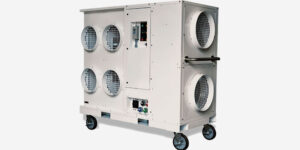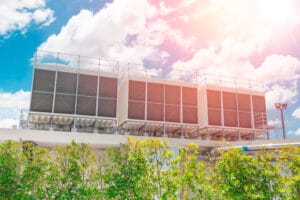Chiller Repair: Troubleshooting and Maintenance Tips for Efficient Cooling
Chiller Repair: Chillers are vital components of many industrial and commercial systems, providing efficient cooling for various applications. However, like any complex machinery, chillers can experience issues and malfunctions over time, leading to reduced performance and increased energy consumption. In this article, we will delve into the world of chiller repair, discussing common problems, troubleshooting techniques, and maintenance tips to ensure optimal chiller performance.
- Understanding Common Chiller Problems: Chillers can encounter several problems that affect their functionality. Some common issues include refrigerant leaks, compressor failures, electrical malfunctions, water flow problems, and control system errors. Identifying the specific problem is the first step toward effective chiller repair.
- Troubleshooting Techniques:
a) Refrigerant Leaks: Leaks can occur in the chiller’s evaporator, condenser, or piping system. Professionals can use various techniques such as pressure testing, thermal imaging, or ultrasonic detection to locate and fix leaks promptly.
b) Compressor Failures: Compressor failures can be caused by various factors, including electrical issues, refrigerant imbalances, or mechanical failures. Troubleshooting involves checking electrical connections, and refrigerant levels, and examining the compressor for signs of damage.
c) Electrical Malfunctions: Electrical problems can disrupt the chiller’s performance. Technicians should inspect electrical components, including wiring, controls, and circuit breakers, to identify any faults and repair or replace damaged parts.
d) Water Flow Problems: Inadequate water flow can result in inefficient cooling. Technicians need to check water pumps, valves, and flow sensors to ensure proper water circulation within the chiller system.
e) Control System Errors: Control system malfunctions can lead to incorrect temperature readings, erratic operation, or system shutdowns. Experts will inspect the control panels, sensors, and programming to diagnose and rectify the issues.
- Preventive Maintenance: Regular maintenance plays a crucial role in preventing chiller breakdowns and minimizing repair costs. Here are some essential maintenance tips:
a) Cleaning: Regularly clean the chiller’s coils, filters, and condenser to prevent dirt and debris buildup, which can hinder performance.
b) Lubrication: Proper lubrication of moving parts such as bearings and motors reduces friction and enhances efficiency. Follow manufacturer guidelines for lubrication intervals.
c) Inspections: Perform routine inspections to identify worn-out components, loose connections, or signs of leaks. Address any minor issues promptly to avoid major breakdowns.
d) Water Treatment: Proper water treatment helps prevent scale, corrosion, and biological growth within the chiller system. Regularly test water quality and employ appropriate treatment methods.
e) Regular Servicing: Schedule professional servicing at regular intervals to assess the overall condition of the chiller, identify potential problems, and optimize its performance.
Conclusion: Efficient chiller repair involves diagnosing and resolving common issues such as refrigerant leaks, compressor failures, electrical malfunctions, water flow problems, and control system errors. Additionally, implementing preventive maintenance measures ensures the longevity and optimal performance of the chiller system. By promptly addressing problems and adhering to regular maintenance practices, businesses can maintain efficient cooling and prolong the lifespan of their chillers, ultimately saving costs and avoiding operational disruptions.
Mastering Chiller Repair: Essential Techniques for Fixing Refrigeration Systems
Chillers are critical components in various industries, providing efficient cooling for refrigeration systems. However, these complex machines can encounter problems over time, leading to decreased performance, energy inefficiency, and potential disruptions in operations. Mastering chiller repair techniques is essential for technicians and engineers to effectively diagnose and fix issues, ensuring the uninterrupted functioning of refrigeration systems. In this article, we will explore the fundamental techniques required to become proficient in chiller repair.
- Understanding Chiller Operation: Before delving into chiller repair, it is crucial to have a comprehensive understanding of chiller operation. Familiarize yourself with the chiller’s components, including compressors, condensers, evaporators, expansion valves, and controls. Understand the refrigeration cycle and how each component contributes to the overall cooling process. This knowledge forms the foundation for troubleshooting and repairing chiller systems.
- Diagnostic Tools and Techniques: Accurate diagnosis is the key to effective chiller repair. Utilize various diagnostic tools and techniques to identify the root causes of chiller malfunctions. Some essential methods include:
a) Pressure and Temperature Measurements: Measure refrigerant pressures and temperatures at various points within the chiller system to determine if they are within the manufacturer’s specifications. Deviations can indicate potential issues.
b) Electrical Testing: Conduct electrical tests to identify faults in motors, control circuits, relays, and wiring. Multimeters, clamp meters, and voltage testers are valuable tools for this purpose.
c) Thermal Imaging: Use thermal imaging cameras to identify temperature variations, which can indicate problems such as refrigerant leaks, insulation issues, or overheating components.
d) Vibration Analysis: Employ vibration analysis techniques to detect abnormalities in rotating machinery, such as compressors and pumps. Excessive vibration can be an early warning sign of impending failures.
- Common Chiller Problems and Solutions: Chillers can experience a range of issues. Here are some common problems and their corresponding repair techniques:
a) Refrigerant Leaks: Identify and repair refrigerant leaks using techniques like pressure testing, ultrasonic detection, or bubble testing. Once the leak is located, repair or replace the affected components and recharge the system with the correct amount of refrigerant.
b) Compressor Failures: Inspect electrical connections, motor windings, and lubrication levels. Replace faulty components, such as capacitors or contactors, and ensure proper lubrication. In severe cases, compressor replacement may be necessary.
c) Control System Malfunctions: Troubleshoot control panels, sensors, and programming to rectify control system errors. Ensure proper calibration and adjustment of setpoints for accurate temperature control.
d) Water Flow Problems: Inspect water pumps, valves, and flow sensors to ensure optimal water flow. Clean or replace clogged filters, repair or replace damaged valves, and verify proper pump operation.
- Preventive Maintenance: Preventive maintenance is crucial for chiller longevity and minimizing repair needs. Establish a regular maintenance schedule that includes the following:
a) Cleaning: Regularly clean condenser coils, evaporator coils, and filters to prevent dirt and debris buildup, which can obstruct heat transfer and airflow.
b) Lubrication: Follow manufacturer guidelines for lubricating bearings, motors, and other moving parts. Proper lubrication reduces friction, prevents wear, and prolongs component life.
c) Inspections: Conduct routine inspections to identify worn-out components, loose connections, or signs of leaks. Addressing minor issues promptly can prevent major breakdowns.
d) Water Treatment: Implement proper water treatment to prevent scale formation, corrosion, and biological growth within the chiller system. Regularly test water quality and apply appropriate treatment methods.
- Professional Development and Training: To master chiller repair, stay updated with industry advancements and technologies. Attend training programs, workshops, and seminars to enhance your skills and knowledge. Seek certification programs that specialize in chiller repair to demonstrate your expertise to employers and clients.
Conclusion: Mastering chiller repair techniques is essential for technicians and engineers responsible for maintaining refrigeration systems. Understanding chiller operation, utilizing diagnostic tools, identifying common problems, and implementing preventive maintenance practices are crucial for effective chiller repair. By continuously honing your skills, staying updated with industry trends, and embracing new technologies, you can ensure efficient chiller operation, prolong the lifespan of refrigeration systems, and minimize downtime, ultimately contributing to the smooth functioning of various industries.
Maintaining Optimal Cooling: The Importance of Chiller Repair and Maintenance
In industries and commercial settings where temperature control is critical, chillers play a vital role in providing efficient cooling. However, to ensure their optimal performance and longevity, regular chiller repair and maintenance are essential. Neglecting these crucial aspects can lead to decreased cooling efficiency, increased energy consumption, and costly breakdowns. In this article, we will explore the importance of chiller repair and maintenance in maintaining optimal cooling and the key benefits they provide.
- Enhancing Energy Efficiency: Chillers consume a significant amount of energy in cooling processes. By investing in regular chiller repair and maintenance, businesses can ensure that their cooling systems operate at peak efficiency. Properly maintained chillers are more energy-efficient, leading to reduced operational costs and a smaller environmental footprint. Routine maintenance tasks such as cleaning condenser coils, checking refrigerant levels, and optimizing water flow contribute to improved efficiency and lowered energy consumption.
- Extending Chiller Lifespan: Chillers are substantial investments, and maximizing their lifespan is crucial for achieving a return on investment. Regular repair and maintenance significantly contribute to extending the chiller’s operational life. Timely identification and resolution of minor issues prevent them from escalating into major problems that could result in costly repairs or premature chiller replacement. Lubricating moving parts, replacing worn-out components, and addressing refrigerant leaks are some maintenance practices that promote the long-term functionality of chillers.
- Avoiding Downtime and Productivity Losses: Unexpected chiller breakdowns can lead to significant downtime, disrupting operations and causing productivity losses. Regular chiller maintenance helps detect and address potential issues before they escalate, minimizing the risk of sudden failures. Scheduled maintenance enables technicians to identify and repair minor faults, replace worn-out parts, and optimize system performance. By proactively managing chiller repair and maintenance, businesses can ensure continuous cooling operations, minimize interruptions, and avoid costly production delays.
- Improving Cooling System Performance: Chillers are intricate systems comprising various components that must work harmoniously to deliver optimal cooling. Over time, factors such as wear and tear, dirt accumulation, and refrigerant leaks can compromise their performance. Routine maintenance, including cleaning condenser and evaporator coils, inspecting electrical connections, and optimizing water flow, helps maintain the chiller’s efficiency. This results in consistent and reliable cooling, ensuring the desired temperature levels are achieved for the specific applications.
- Safety and Compliance: Chillers operate under specific safety standards and regulations. Neglected maintenance can lead to safety hazards, including electrical malfunctions or refrigerant leaks. Regular chiller inspections and maintenance help identify and rectify potential safety risks. Additionally, adhering to maintenance schedules ensures compliance with regulatory requirements, minimizing the risk of penalties or legal consequences.
- Cost Savings: Investing in chiller repair and maintenance offers significant cost savings in the long run. Timely detection and repair of issues prevent them from escalating into expensive repairs or complete system failure. By optimizing chiller performance and energy efficiency, maintenance practices contribute to reduced energy bills. Furthermore, extending the lifespan of chillers minimizes the need for premature replacement, saving businesses substantial capital expenditure.
Conclusion: Maintaining optimal cooling in industrial and commercial settings relies on regular chiller repair and maintenance. By prioritizing these essential tasks, businesses can enhance energy efficiency, extend chiller lifespan, avoid downtime, improve cooling system performance, ensure safety compliance, and achieve cost savings. Implementing a proactive maintenance program, including routine inspections, cleaning, lubrication, and addressing issues promptly, will maximize the chiller’s performance, reduce operational costs, and provide reliable cooling for critical applications.
From Leaks to Compressor Failures: Demystifying Chiller Repair Techniques
Chillers are complex and crucial components in various industrial and commercial settings, providing efficient cooling for a wide range of applications. However, over time, chillers may experience issues such as refrigerant leaks and compressor failures, which can disrupt their performance and compromise cooling capabilities. To effectively address these problems, it is important to demystify chiller repair techniques. In this article, we will explore the common repair techniques used to tackle issues ranging from leaks to compressor failures, helping technicians and engineers troubleshoot and resolve chiller problems with confidence.
- Refrigerant Leaks: Detection and Repair: Refrigerant leaks are a common problem in chiller systems and can lead to reduced cooling efficiency and environmental concerns. To tackle refrigerant leaks, technicians employ various techniques, including:
a) Pressure Testing: Utilize pressure testing methods to identify leaks in the chiller system. This involves pressurizing the system with a test gas and using specialized equipment to detect any pressure drop, indicating the presence of a leak.
b) Ultrasonic Detection: Ultrasonic detection devices can be used to locate refrigerant leaks by detecting the high-frequency sound emitted when the gas escapes. Technicians can pinpoint the exact location of the leak, enabling precise repair or replacement of the affected components.
c) Bubble Testing: Applying a soapy solution to potential leak points and observing the formation of bubbles can also help identify leaks. This technique is particularly effective for identifying smaller leaks in accessible areas.
Once the leaks are identified, repairs involve sealing or replacing damaged gaskets, O-rings, or tubing connections. After the repairs, the system is thoroughly checked to ensure there are no remaining leaks.
- Compressor Failures: Diagnosis and Resolution: Compressor failures can significantly impact chiller performance and require prompt attention. Some common causes of compressor failures include electrical issues, refrigerant imbalances, or mechanical failures. To address compressor failures, technicians employ the following techniques:
a) Electrical Testing: Check the electrical connections, including wiring, contactors, capacitors, and relays, to identify any faults or malfunctions. Ensure proper voltage supply and continuity of electrical circuits.
b) Refrigerant Analysis: Analyze the refrigerant to assess its quality and composition. Imbalances in refrigerant levels or contaminants can cause compressor strain and potential failure. Recharging the system with the correct refrigerant and ensuring optimal levels is crucial.
c) Mechanical Inspection: Thoroughly inspect the compressor for signs of wear, damage, or mechanical failures. This includes checking motor windings, bearings, and lubrication levels. Replace worn-out parts, and ensure proper lubrication for smooth compressor operation.
In severe cases where compressor failure is irreversible, replacing the compressor may be necessary. It is important to address the root cause of the failure to prevent a recurrence.
- Preventive Measures: Prevention is key to minimizing the occurrence of chiller issues. Implementing preventive measures can help reduce the likelihood of leaks and compressor failures. Key preventive measures include:
a) Regular Maintenance: Develop a comprehensive maintenance schedule, including tasks such as cleaning coils, inspecting electrical connections, checking refrigerant levels, and monitoring oil quality. Regular maintenance helps identify potential issues before they escalate.
b) Lubrication: Ensure proper lubrication of compressor bearings, motors, and other moving parts. Follow manufacturer guidelines for lubricant selection and recommended intervals.
c) System Monitoring: Implement a robust system monitoring program to track performance parameters such as temperatures, pressures, and energy consumption. Analyzing trends and identifying deviations can help identify potential problems before they lead to failures.
Conclusion: Chiller repair techniques involve addressing a range of issues, from refrigerant leaks to compressor failures. By employing appropriate techniques such as pressure testing, ultrasonic detection, and bubble testing, technicians can identify and repair refrigerant leaks effectively. Similarly, electrical testing, refrigerant analysis, and mechanical inspection aid in diagnosing and resolving compressor failures. Implementing preventive measures and regular maintenance can help minimize the occurrence of these problems. By demystifying chiller repair techniques, technicians and engineers can confidently maintain the optimal performance of chillers and ensure uninterrupted cooling for critical applications.
Maximizing Efficiency: Proven Strategies for Successful Chiller Repair and Troubleshooting
Efficient and reliable chillers are vital components in various industries, providing critical cooling for processes and equipment. However, like any complex machinery, chillers can experience issues that hinder their performance and energy efficiency. Successful chiller repair and troubleshooting strategies are essential to maximize their efficiency and minimize downtime. In this article, we will explore proven strategies that help technicians and engineers achieve successful chiller repair and troubleshooting, ensuring optimal cooling and cost savings.
- Comprehensive Diagnosis: Effective chiller repair starts with a comprehensive diagnosis. Take a systematic approach to identify the root cause of the problem. Gather information about the chiller’s history, review maintenance records, and interview operators to gain insights into any recent changes or events that may have contributed to the issue. Utilize diagnostic tools such as pressure gauges, temperature sensors, and data loggers to monitor and analyze critical parameters. By understanding the problem’s underlying cause, you can implement targeted repair strategies.
- Planned Preventive Maintenance: Implementing a proactive preventive maintenance program is crucial for maximizing chiller efficiency. Regularly scheduled maintenance tasks help identify and address potential issues before they escalate. Key maintenance activities include cleaning condenser and evaporator coils, inspecting electrical connections, lubricating moving parts, and checking refrigerant levels. Adhering to manufacturer recommendations and industry best practices ensures optimal chiller performance, extends equipment lifespan, and minimizes unexpected breakdowns.
- Thorough Cleaning and Inspections: Dirt and debris accumulation on chiller components can impede heat transfer and reduce efficiency. Regular cleaning of condenser and evaporator coils, filters, and heat exchangers is essential to maintain optimal performance. Use appropriate cleaning techniques, such as water flushing, chemical cleaning, or air pressure cleaning, depending on the component and level of contamination. Inspect key areas for leaks, loose connections, and signs of wear or damage. Thorough cleaning and inspections improve system efficiency and prevent potential failures.
- Efficient Refrigerant Management: Proper refrigerant management is critical for chiller efficiency. Ensure refrigerant levels are within the manufacturer’s specifications and the system is free from leaks. Regularly monitor refrigerant pressures, temperatures, and superheat/subcooling values to ensure optimal operation. If leaks are detected, use proven techniques such as pressure testing, ultrasonic detection, or thermal imaging to identify and repair them promptly. Efficient refrigerant management maximizes cooling capacity, reduces energy consumption, and lowers environmental impact.
- Collaboration and Knowledge Sharing: Effective chiller repair and troubleshooting often require collaboration among different stakeholders. Encourage open communication between operators, maintenance personnel, and equipment manufacturers. Share knowledge and experiences to enhance problem-solving capabilities and identify potential improvement opportunities. Engage in continuous learning through training programs, industry conferences, and staying updated with the latest advancements in chiller technology. Building a network of experts and sharing best practices enhances the overall efficiency of chiller repair and troubleshooting efforts.
- Documentation and Analysis: Maintain comprehensive documentation of chiller repair and troubleshooting activities. This includes recording maintenance schedules, repairs performed, replaced components, and any notable observations. Analyze historical data to identify recurring issues or patterns that may indicate underlying systemic problems. Use this information to refine preventive maintenance strategies, update troubleshooting procedures, and improve overall chiller performance.
Conclusion: Maximizing chiller efficiency requires successful repair and troubleshooting strategies. By following proven techniques such as comprehensive diagnosis, planned preventive maintenance, thorough cleaning and inspections, efficient refrigerant management, collaboration, and documentation, technicians and engineers can optimize chiller performance, minimize energy consumption, and reduce downtime. Embracing these strategies ensures that chillers operate at peak efficiency, contributing to cost savings, sustainability, and uninterrupted cooling for critical processes and equipment.
Address
7200 Distribution Dr, Louisville, KY 40258Phone: (502) 384-8500 Email: ACS.receptionist@AllianceComfortSys.com
Opening Hours
| Monday | 9:00 a.m. – 5:00 p.m. |
| Tuesday | 9:00 a.m. – 5:00 p.m. |
| Wednesday | 9:00 a.m. – 5:00 p.m. |
| Thursday | 9:00 a.m. – 5:00 p.m. |
| Friday | 9:00 a.m. – 5:00 p.m. |
| Saturday | Closed |
| Sunday | Closed |












